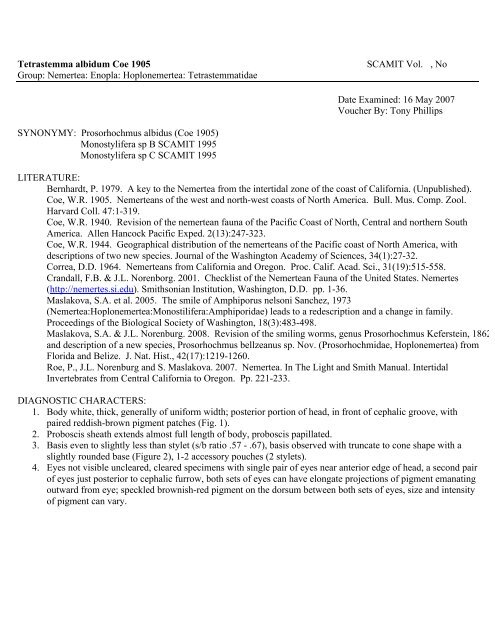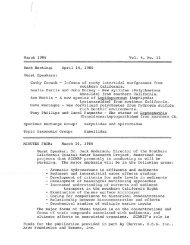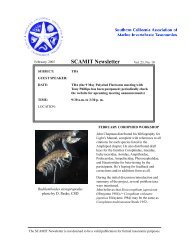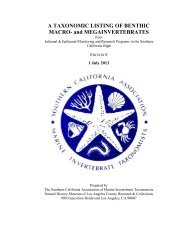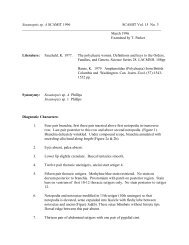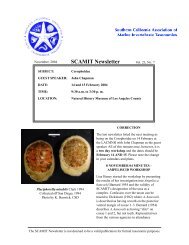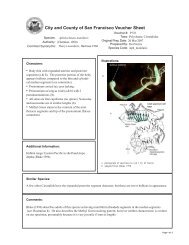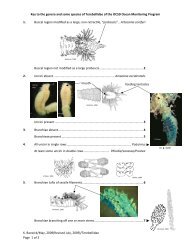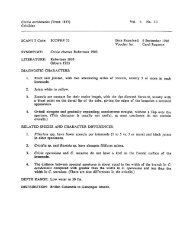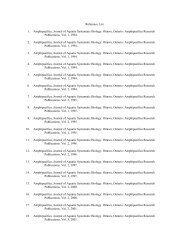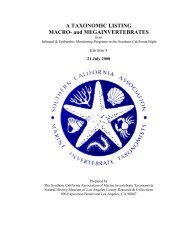Tetrastemma albidum Coe 1905 SCAMIT Vol. , No Group: Nemertea ...
Tetrastemma albidum Coe 1905 SCAMIT Vol. , No Group: Nemertea ...
Tetrastemma albidum Coe 1905 SCAMIT Vol. , No Group: Nemertea ...
Create successful ePaper yourself
Turn your PDF publications into a flip-book with our unique Google optimized e-Paper software.
<strong>Tetrastemma</strong> <strong>albidum</strong> <strong>Coe</strong> <strong>1905</strong> <strong>SCAMIT</strong> <strong>Vol</strong>. , <strong>No</strong><br />
<strong>Group</strong>: <strong>Nemertea</strong>: Enopla: Hoplonemertea: <strong>Tetrastemma</strong>tidae<br />
SYNONYMY: Prosorhochmus albidus (<strong>Coe</strong> <strong>1905</strong>)<br />
Monostylifera sp B <strong>SCAMIT</strong> 1995<br />
Monostylifera sp C <strong>SCAMIT</strong> 1995<br />
Date Examined: 16 May 2007<br />
Voucher By: Tony Phillips<br />
LITERATURE:<br />
Bernhardt, P. 1979. A key to the <strong>Nemertea</strong> from the intertidal zone of the coast of California. (Unpublished).<br />
<strong>Coe</strong>, W.R. <strong>1905</strong>. <strong>Nemertea</strong>ns of the west and north-west coasts of <strong>No</strong>rth America. Bull. Mus. Comp. Zool.<br />
Harvard Coll. 47:1-319.<br />
<strong>Coe</strong>, W.R. 1940. Revision of the nemertean fauna of the Pacific Coast of <strong>No</strong>rth, Central and northern South<br />
America. Allen Hancock Pacific Exped. 2(13):247-323.<br />
<strong>Coe</strong>, W.R. 1944. Geographical distribution of the nemerteans of the Pacific coast of <strong>No</strong>rth America, with<br />
descriptions of two new species. Journal of the Washington Academy of Sciences, 34(1):27-32.<br />
Correa, D.D. 1964. <strong>Nemertea</strong>ns from California and Oregon. Proc. Calif. Acad. Sci., 31(19):515-558.<br />
Crandall, F.B. & J.L. <strong>No</strong>renborg. 2001. Checklist of the <strong>Nemertea</strong>n Fauna of the United States. Nemertes<br />
(http://nemertes.si.edu). Smithsonian Institution, Washington, D.D. pp. 1-36.<br />
Maslakova, S.A. et al. 2005. The smile of Amphiporus nelsoni Sanchez, 1973<br />
(<strong>Nemertea</strong>:Hoplonemertea:Monostilifera:Amphiporidae) leads to a redescription and a change in family.<br />
Proceedings of the Biological Society of Washington, 18(3):483-498.<br />
Maslakova, S.A. & J.L. <strong>No</strong>renburg. 2008. Revision of the smiling worms, genus Prosorhochmus Keferstein, 1862,<br />
and description of a new species, Prosorhochmus bellzeanus sp. <strong>No</strong>v. (Prosorhochmidae, Hoplonemertea) from<br />
Florida and Belize. J. Nat. Hist., 42(17):1219-1260.<br />
Roe, P., J.L. <strong>No</strong>renburg and S. Maslakova. 2007. <strong>Nemertea</strong>. In The Light and Smith Manual. Intertidal<br />
Invertebrates from Central California to Oregon. Pp. 221-233.<br />
DIAGNOSTIC CHARACTERS:<br />
1. Body white, thick, generally of uniform width; posterior portion of head, in front of cephalic groove, with<br />
paired reddish-brown pigment patches (Fig. 1).<br />
2. Proboscis sheath extends almost full length of body, proboscis papillated.<br />
3. Basis even to slightly less than stylet (s/b ratio .57 - .67), basis observed with truncate to cone shape with a<br />
slightly rounded base (Figure 2), 1-2 accessory pouches (2 stylets).<br />
4. Eyes not visible uncleared, cleared specimens with single pair of eyes near anterior edge of head, a second pair<br />
of eyes just posterior to cephalic furrow, both sets of eyes can have elongate projections of pigment emanating<br />
outward from eye; speckled brownish-red pigment on the dorsum between both sets of eyes, size and intensity<br />
of pigment can vary.
RELATED SPECIES AND CHARACTER<br />
DIFFERENCES:<br />
This is the only species of <strong>Tetrastemma</strong><br />
observed that has pigment patches on<br />
the head in the southern California<br />
Bight. It is also the only species of<br />
<strong>Tetrastemma</strong> that has a truncate basis<br />
(Figure 2). At this time Dr. Svetlana<br />
Maslakova feels that this species<br />
should be left as a <strong>Tetrastemma</strong>. The<br />
primary external morphological<br />
character of Prosorhochmus is the<br />
prosorhochmid “smile” (see Maslakova<br />
& <strong>No</strong>renburg, 2008), a horizontal<br />
transverse epithelial fold on the head<br />
that has not been observed in any of the<br />
specimens I examined. They examined<br />
specimens collected from southern<br />
California in 2002 and found a couple<br />
of species that fit <strong>Coe</strong>’s original description, but is certain neither is a Prosorhochmus due to the above<br />
mentioned morphological character and other internal characters. For now they feel that this species is of<br />
uncertain taxonomic affinities and best to leave as T. <strong>albidum</strong>. Until an acceptable revision and diagnosis of<br />
the genus <strong>Tetrastemma</strong> is completed and the proper designation of T. <strong>albidum</strong> can be ascertained, they feel it<br />
is best to re-establish the original designation of <strong>Coe</strong>.<br />
DEPTH RANGE: 10 - 127 meters<br />
DISTRIBUTION: San Diego to San Francisco<br />
Figure 2. Stylet (14µ) and basis (30µ)<br />
Figure 1. <strong>Tetrastemma</strong> <strong>albidum</strong>


